我们先来看一个简单的 demo:
import * as React from ‘react‘;
import * as ReactDOM from ‘react-dom‘;
class App extends React.Component {
render() {
return (
<div className="container">
<div className="section">
<h1>This is the title.</h1>
<p>This is the first paragraph.</p>
<p>This is the second paragraph.</p>
</div>
</div>
);
}
}
ReactDOM.render(<App />, document.getElementById(‘root‘));
首次渲染的调用栈如下图

以 performSyncWorkOnRoot 和 commitRoot 两个方法为界限,可以把 ReactDOM.render 分为三个阶段:
很简单,直接调用 legacyRenderSubtreeIntoContainer。
export function render(
element: React$Element<any>,
container: Container,
callback: ?Function,
) {
// 省略对 container 的校验逻辑
return legacyRenderSubtreeIntoContainer(
null,
element,
container,
false,
callback,
);
}
这里需要注意一点,此时的 element 已经不是 render 中传入的
在这里我们可以看到方法取名的重要性,一个好的方法名可以让你一眼就看出这个方法的作用。legacyRenderSubtreeIntoContainer,顾名思义,这是一个遗留的方法,作用是渲染子树并将其挂载到 container 上。再来看一下入参,children 和 container 分别是之前传入 render 方法的 App 元素和 id 为 root 的 DOM 元素,所以可以看出这个方法会根据 App 元素生成对应的 DOM 树,并将其挂在到 root 元素上。
function legacyRenderSubtreeIntoContainer(
parentComponent: ?React$Component<any, any>,
children: ReactNodeList,
container: Container,
forceHydrate: boolean,
callback: ?Function,
) {
let root: RootType = (container._reactRootContainer: any);
let fiberRoot;
if (!root) {
root = container._reactRootContainer = legacyCreateRootFromDOMContainer(
container,
forceHydrate,
);
fiberRoot = root._internalRoot;
// 省略对 callback 的处理逻辑
unbatchedUpdates(() => {
updateContainer(children, fiberRoot, parentComponent, callback);
});
} else {
// 省略 else 逻辑
}
return getPublicRootInstance(fiberRoot);
}
下面来细看一下这个方法:
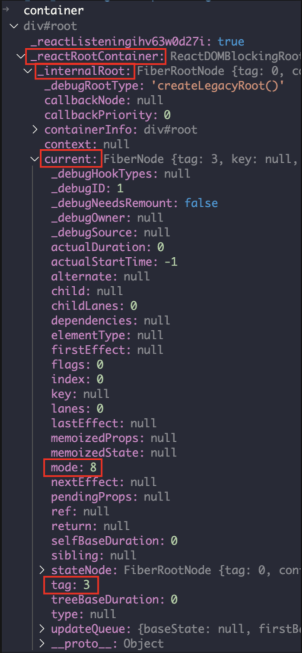
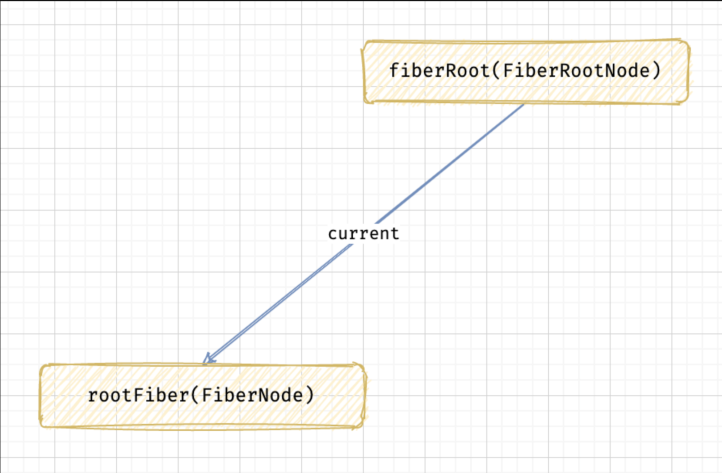
主要逻辑就是调用回调函数 fn,也就是之前传入的 updateContainer。
export function unbatchedUpdates<A, R>(fn: (a: A) => R, a: A): R {
const prevExecutionContext = executionContext;
executionContext &= ~BatchedContext;
executionContext |= LegacyUnbatchedContext;
try {
// fn 为之前传入的 updateContainer
return fn(a);
} finally {
executionContext = prevExecutionContext;
if (executionContext === NoContext) {
resetRenderTimer();
flushSyncCallbackQueue();
}
}
}
updateContainer 方法做的还是一些杂活,我们简单总结一下:
export function updateContainer(
element: ReactNodeList,
container: OpaqueRoot,
parentComponent: ?React$Component<any, any>,
callback: ?Function,
): Lane {
const current = container.current;
const eventTime = requestEventTime();
// 计算当前节点的 lane(优先级)
const lane = requestUpdateLane(current);
if (enableSchedulingProfiler) {
markRenderScheduled(lane);
}
const context = getContextForSubtree(parentComponent);
if (container.context === null) {
container.context = context;
} else {
container.pendingContext = context;
}
// 根据 lane(优先级)计算当前节点的 update 对象
const update = createUpdate(eventTime, lane);
update.payload = {element};
callback = callback === undefined ? null : callback;
if (callback !== null) {
update.callback = callback;
}
// 将 update 对象入队
enqueueUpdate(current, update);
// 调度当前 Fiber节点(rootFiber)
scheduleUpdateOnFiber(current, lane, eventTime);
return lane;
}
接着会进入 scheduleUpdateOnFiber 方法,根据 lane(优先级)等于 SyncLane,代码最终会执行 performSyncWorkOnRoot 方法。performSyncWorkOnRoot 翻译过来,就是指执行根节点(rootFiber)的同步任务,所以 ReactDOM.render 的首次渲染其实是一个同步的过程。
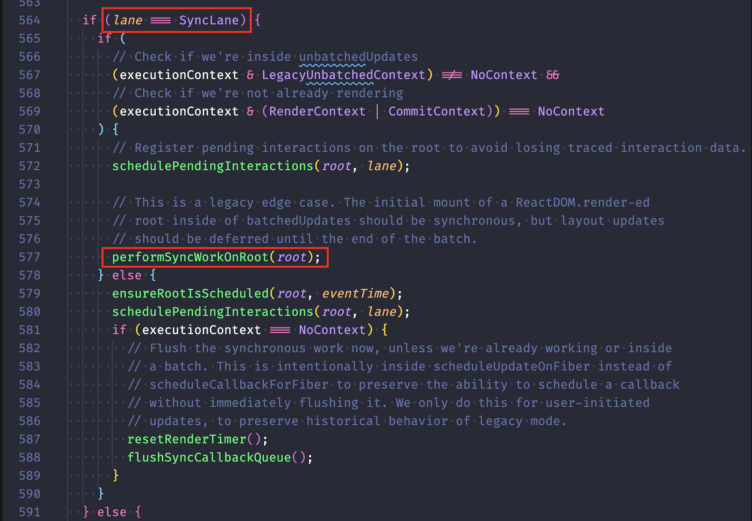
到这里大家可能会有个疑问,为什么 ReactDOM.render 触发的首次渲染是一个同步的过程呢?不是说在新的 Fiber 架构下,render 阶段是一个可打断的异步过程。
我们先来看看 lane 是怎么计算得到的,相关逻辑在 updateContainer 中的 requestUpdateLane 方法里:
export function requestUpdateLane(fiber: Fiber): Lane {
const mode = fiber.mode;
if ((mode & BlockingMode) === NoMode) {
return (SyncLane: Lane);
} else if ((mode & ConcurrentMode) === NoMode) {
return getCurrentPriorityLevel() === ImmediateSchedulerPriority
? (SyncLane: Lane)
: (SyncBatchedLane: Lane);
} else if (
!deferRenderPhaseUpdateToNextBatch &&
(executionContext & RenderContext) !== NoContext &&
workInProgressRootRenderLanes !== NoLanes
) {
return pickArbitraryLane(workInProgressRootRenderLanes);
}
// 省略非核心代码
}
可以看出 lane 的计算是由当前 Fiber 节点(rootFiber)的 mode 属性决定的,这里的 mode 属性其实指的就是当前 Fiber 节点的渲染模式,而 rootFiber 的 mode 属性其实最终是由 React 的启动方式决定的。
React 其实有三种启动模式:
ReactDOM.render(<App />, rootNode)。这是目前 React App 使用的方式,当前没有删除这个模式的计划,但是这个模式不支持一些新的功能。ReactDOM.createBlockingRoot(rootNode).render(<App />)。目前正在实验中,作为迁移到 concurrent 模式的第一个步骤。ReactDOM.createRoot(rootNode).render(<App />)。目前正在实验中,在未来稳定之后,将作为 React 的默认启动方式。此模式启用所有新功能。因此不同的渲染模式在挂载阶段的差异,本质上来说并不是工作流的差异(其工作流涉及 初始化 → render → commit 这 3 个步骤),而是 mode 属性的差异。mode 属性决定着这个工作流是一气呵成(同步)的,还是分片执行(异步)的。
核心是调用 renderRootSync 方法
有两个核心方法 prepareFreshStack 和 workLoopSync,下面来逐个分析。
首先调用 prepareFreshStack 方法,prepareFreshStack 中有一个重要的方法 createWorkInProgress。
export function createWorkInProgress(current: Fiber, pendingProps: any): Fiber {
let workInProgress = current.alternate;
if (workInProgress === null) {
// 通过 current 创建 workInProgress
workInProgress = createFiber(
current.tag,
pendingProps,
current.key,
current.mode,
);
workInProgress.elementType = current.elementType;
workInProgress.type = current.type;
workInProgress.stateNode = current.stateNode;
// 使 workInProgress 与 current 通过 alternate 相互指向
workInProgress.alternate = current;
current.alternate = workInProgress;
} else {
// 省略 else 逻辑
}
// 省略对 workInProgress 属性的处理逻辑
return workInProgress;
}
下面我们来看一下 workInProgress 究竟是什么?workInProgress 是 createFiber 的返回值,接着来看一下 createFiber。
const createFiber = function(
tag: WorkTag,
pendingProps: mixed,
key: null | string,
mode: TypeOfMode,
): Fiber {
return new FiberNode(tag, pendingProps, key, mode);
};
可以看出 createFiber 其实就是在创建一个 Fiber 节点。所以说 workInProgress 其实就是一个 Fiber 节点。
从 createWorkInProgress 中,我们还可以看出:
所以到现在为止,我们的 Fiber 树如下:
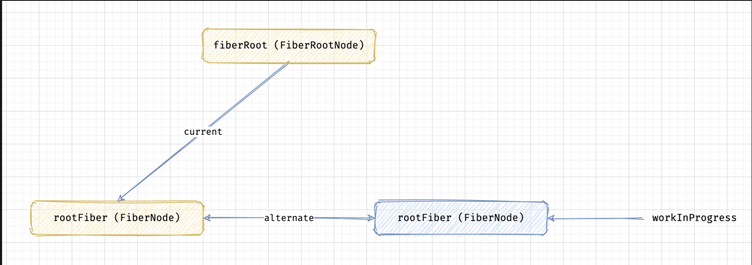
接下来调用 workLoopSync 方法,代码很简单,若 workInProgress 不为空,调用 performUnitOfWork 处理 workInProgress 节点。
function workLoopSync() {
while (workInProgress !== null) {
performUnitOfWork(workInProgress);
}
}
performUnitOfWork 有两个重要的方法 beginWork 和 completeUnitOfWork,在 Fiber 的构建过程中,我们只需重点关注 beginWork 这个方法。
function performUnitOfWork(unitOfWork: Fiber): void {
const current = unitOfWork.alternate;
setCurrentDebugFiberInDEV(unitOfWork);
let next;
if (enableProfilerTimer && (unitOfWork.mode & ProfileMode) !== NoMode) {
startProfilerTimer(unitOfWork);
next = beginWork(current, unitOfWork, subtreeRenderLanes);
stopProfilerTimerIfRunningAndRecordDelta(unitOfWork, true);
} else {
next = beginWork(current, unitOfWork, subtreeRenderLanes);
}
resetCurrentDebugFiberInDEV();
unitOfWork.memoizedProps = unitOfWork.pendingProps;
if (next === null) {
completeUnitOfWork(unitOfWork);
} else {
workInProgress = next;
}
ReactCurrentOwner.current = null;
}
目前我们只能看出,它会对当前的 workInProgress 节点进行处理,至于怎么处理的,当我们解析完 beginWork 方法再来总结 performUnitOfWork 的作用。
根据 workInProgress 节点的 tag 进行逻辑分发。tag 属性代表的是当前 Fiber 节点的类型,常见的有下面几种:
function beginWork(
current: Fiber | null,
workInProgress: Fiber,
renderLanes: Lanes,
): Fiber | null {
// 省略非核心(针对树构建)逻辑
switch (workInProgress.tag) {
// 省略部分 case 逻辑
// 函数组件(包括 Hooks)
case FunctionComponent: {
const Component = workInProgress.type;
const unresolvedProps = workInProgress.pendingProps;
const resolvedProps =
workInProgress.elementType === Component
? unresolvedProps
: resolveDefaultProps(Component, unresolvedProps);
return updateFunctionComponent(
current,
workInProgress,
Component,
resolvedProps,
renderLanes,
);
}
// 类组件
case ClassComponent: {
const Component = workInProgress.type;
const unresolvedProps = workInProgress.pendingProps;
const resolvedProps =
workInProgress.elementType === Component
? unresolvedProps
: resolveDefaultProps(Component, unresolvedProps);
return updateClassComponent(
current,
workInProgress,
Component,
resolvedProps,
renderLanes,
);
}
// 根节点
case HostRoot:
return updateHostRoot(current, workInProgress, renderLanes);
// DOM 元素
case HostComponent:
return updateHostComponent(current, workInProgress, renderLanes);
// 文本节点
case HostText:
return updateHostText(current, workInProgress);
// 省略部分 case 逻辑
}
// 省略匹配不上的错误处理
}
当前的 workInProgress 节点为 rootFiber,tag 对应为 HostRoot,会调用 updateHostRoot 方法。
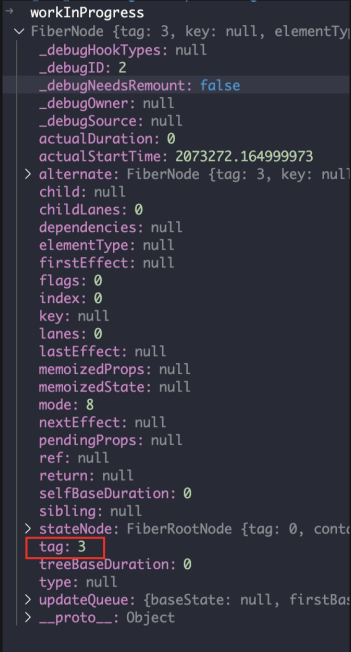
rootFiber 的 tag(HostRoot)是什么来的?核心代码如下:
export function createHostRootFiber(tag: RootTag): Fiber {
// 省略非核心代码
return createFiber(HostRoot, null, null, mode);
}
在创建 rootFiber 节点的时候,直接指定了 tag 参数为 HostRoot。
updateHostRoot 的主要逻辑如下:
function updateHostRoot(current, workInProgress, renderLanes) {
// 省略非核心逻辑
if (root.hydrate && enterHydrationState(workInProgress)) {
// 省略 if 成立的逻辑
} else {
reconcileChildren(current, workInProgress, nextChildren, renderLanes);
resetHydrationState();
}
return workInProgress.child;
}
这里有一点需要注意,通过查看源码,你会发现不仅是 updateHostRoot 方法,所以的更新方法最终都会调用下面这个方法:
reconcileChildren(current, workInProgress, nextChildren, renderLanes);
只是针对不同的节点类型,会有一些不同的处理,最终殊途同归。
reconcileChildren 根据 current 是否为空进行逻辑分发。
export function reconcileChildren(
current: Fiber | null,
workInProgress: Fiber,
nextChildren: any,
renderLanes: Lanes,
) {
if (current === null) {
workInProgress.child = mountChildFibers(
workInProgress,
null,
nextChildren,
renderLanes,
);
} else {
workInProgress.child = reconcileChildFibers(
workInProgress,
current.child,
nextChildren,
renderLanes,
);
}
}
此时 current 节点不为空,会走 else 逻辑,调用 reconcileChildFibers 创建 workInProgress.child 对象。
根据 newChild 的类型进行不同的逻辑处理。
function reconcileChildFibers(
returnFiber: Fiber,
currentFirstChild: Fiber | null,
newChild: any,
lanes: Lanes,
): Fiber | null {
// 省略非核心代码
const isObject = typeof newChild === ‘object‘ && newChild !== null;
if (isObject) {
switch (newChild.$$typeof) {
case REACT_ELEMENT_TYPE:
return placeSingleChild(
reconcileSingleElement(
returnFiber,
currentFirstChild,
newChild,
lanes,
),
);
// 省略其他 case 逻辑
}
}
// 省略非核心代码
if (isArray(newChild)) {
return reconcileChildrenArray(
returnFiber,
currentFirstChild,
newChild,
lanes,
);
}
// 省略非核心代码
}
newChild 很关键,我们先明确一下 newChild 究竟是什么?通过层层向上寻找,你会在 updateHostRoot 方法中发现它其实是最开始传入 render 方法的 App 元素,它在 updateHostRoot 中被叫做 nextChildren,到这里我们可以做出这样的猜想,rootFiber 的下一个是 App 节点,并且 App 节点是由 App 元素生成的,下面来看一下 newChild 的结构:
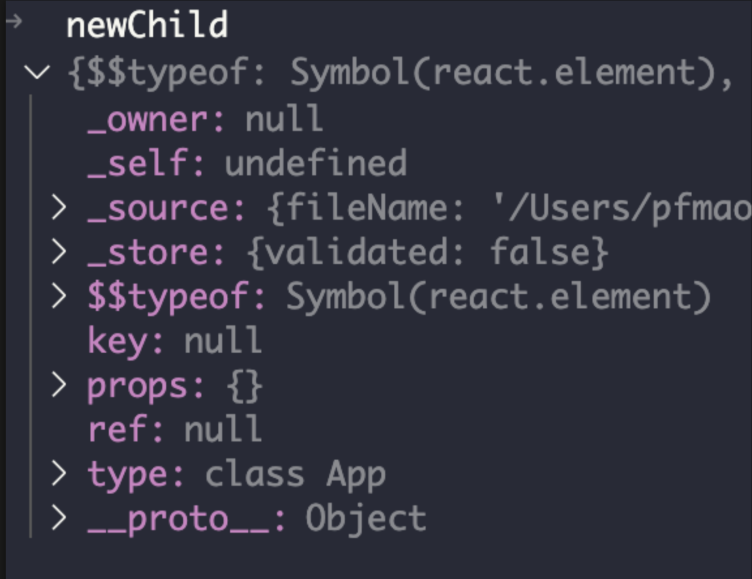
可以看出 newChild 类型为 object,$$typeof 属性为 REACT_ELEMENT_TYPE,所以会调用:
placeSingleChild(
reconcileSingleElement(
returnFiber,
currentFirstChild,
newChild,
lanes,
),
);
下面继续看 reconcileSingleElement 这个方法:
function reconcileSingleElement(
returnFiber: Fiber,
currentFirstChild: Fiber | null,
element: ReactElement,
lanes: Lanes,
): Fiber {
const key = element.key;
let child = currentFirstChild;
// 省略 child 不存在的处理逻辑
if (element.type === REACT_FRAGMENT_TYPE) {
// 省略 if 成立的处理逻辑
} else {
const created = createFiberFromElement(element, returnFiber.mode, lanes);
created.ref = coerceRef(returnFiber, currentFirstChild, element);
created.return = returnFiber;
return created;
}
}
方法的调用比较深,我们先明确一下入参,returnFiber 为 workInProgress 节点,element 其实就是传入的 newChild,也就是 App 元素,所以这个方法的作用为:
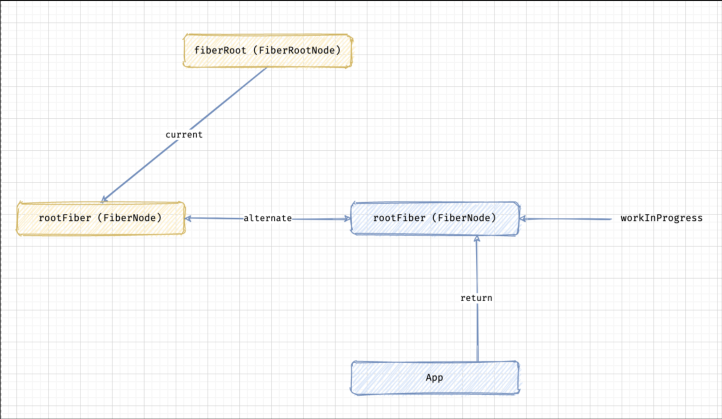
接下来调用 placeSingleChild:
function placeSingleChild(newFiber: Fiber): Fiber {
if (shouldTrackSideEffects && newFiber.alternate === null) {
newFiber.flags = Placement;
}
return newFiber;
}
入参为之前创建的 App 节点,它的作用为:
之后 App 节点会被一路返回到的 reconcileChildren 方法:
workInProgress.child = reconcileChildFibers(
workInProgress,
current.child,
nextChildren,
renderLanes,
);
此时 workInProgress 节点的 child 属性会指向 App 节点。此时 Fiber 树为:
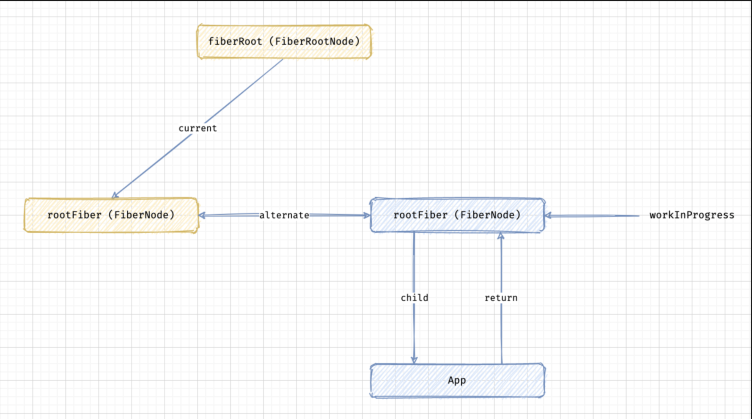
beginWork 的链路比较长,我们来梳理一下:
简单来说就是创建新的 Fiber 字节点,并将其挂载到 Fiber 树上,最后返回新创建的子节点。
下面我们来小结一下 performUnitOfWork 这个方法,先来回顾一下 workLoopSync 方法。
function workLoopSync() {
while (workInProgress !== null) {
performUnitOfWork(workInProgress);
}
}
它会循环执行 performUnitOfWork,而 performUnitOfWork,我们已经知道它会通过 beginWork 创建新的 Fiber 节点。它还有另外一个作用,那就是把 workInProgress 更新为新创建的 Fiber 节点,相关逻辑如下:
// 省略非核心代码
// beginWork 返回新创建的 Fiber 节点并赋值给 next
next = beginWork(current, unitOfWork, subtreeRenderLanes);
// 省略非核心代码
if (next === null) {
completeUnitOfWork(unitOfWork);
} else {
// 若 Fiber 节点不为空则将 workInProgress 更新为新创建的 Fiber 节点
workInProgress = next;
}
所以当 performUnitOfWork 执行完,当前的 workInProgress 都存储着下次要处理的 Fiber 节点,为下一次的 workLoopSync 做准备。
performUnitOfWork 作用总结如下:
rootFiber 节点处理完成之后,对应的 Fiber 树如下:

接下来 performUnitOfWork 会开始处理 App 节点。App 节点的处理过程大致与 rootFiber 节点类似,就是调用 beginWork 创建新的子节点,也就是 className 为 container 的 div 节点,处理完成之后的 Fiber 树如下:
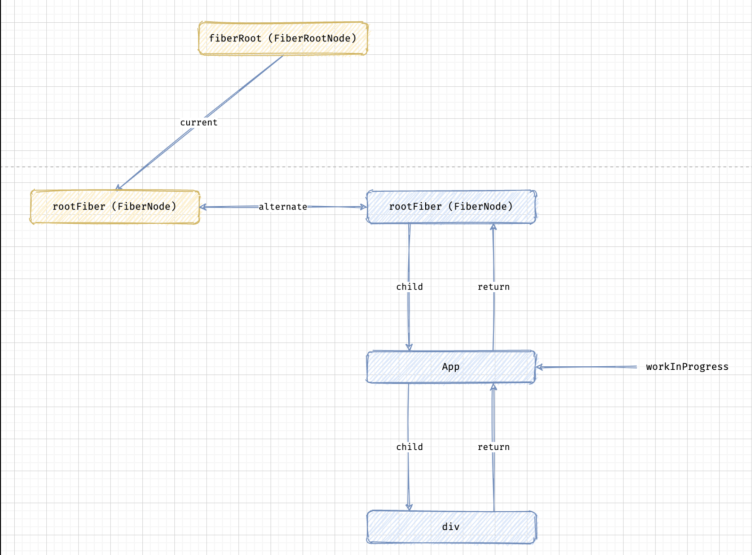
这里有一个很关键的地方需要大家注意。我们先回忆一下对 rootFiber 的处理,针对 rootFiber,我们已经知道在 updateHostRoot 中,它会提取出 nextChildren,也就是最初传入 render 方法的 element。
那针对 App 节点,它是如何获取 nextChildren 的呢?先来看下我们的 App 组件:
class App extends React.Component {
render() {
return (
<div className="container">
<div className="section">
<h1>This is the title.</h1>
<p>This is the first paragraph.</p>
<p>This is the second paragraph.</p>
</div>
</div>
);
}
}
我们的 App 是一个 class,React 首先会实例化会它:

之后会把生成的实例挂在到当前 workInProgress 节点,也就是 App 节点的 stateNode 属性上:

然后在 updateClassComponent 方法中,会先初始化 instance 为 workInProgress.stateNode,之后调用 instance 的 render 方法并赋值给 nextChildren:
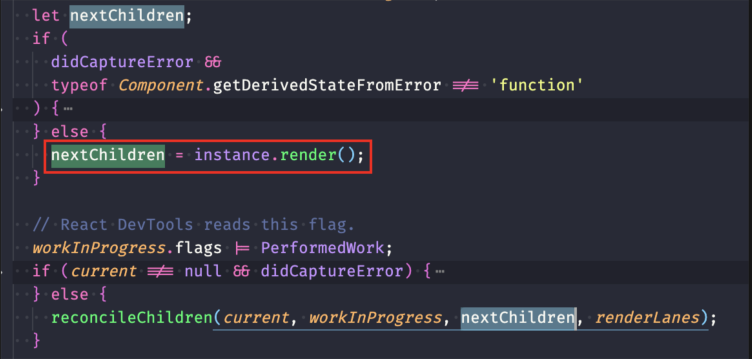
此时的 nextChildren 为下面 JSX 经过 React.createElement 转化后的结果:
<div className="container">
<div className="section">
<h1>This is the title.</h1>
<p>This is the first paragraph.</p>
<p>This is the second paragraph.</p>
</div>
</div>
接着来看一下 nextChildren 长啥样:
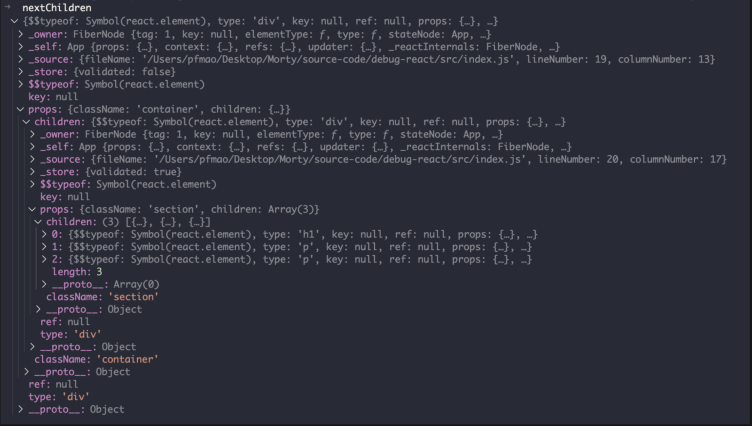
props.children 存储的是其子节点,它可以是对象也可以是数组。对于 App 节点和第一个 div 节点,它们都只有一个子节点。对于第二个 div 节点,它有三个子节点,分别是 h1、p、p,所以它的 children 为数组。
并且 props 还会保存在新生成的 Fiber 节点的 pendingProps 属性上,相关逻辑如下:
export function createFiberFromElement(
element: ReactElement,
mode: TypeOfMode,
lanes: Lanes,
): Fiber {
let owner = null;
const type = element.type;
const key = element.key;
const pendingProps = element.props;
const fiber = createFiberFromTypeAndProps(
type,
key,
pendingProps,
owner,
mode,
lanes,
);
return fiber;
}
export function createFiberFromTypeAndProps(
type: any, // React$ElementType
key: null | string,
pendingProps: any,
owner: null | Fiber,
mode: TypeOfMode,
lanes: Lanes,
): Fiber {
// 省略非核心逻辑
const fiber = createFiber(fiberTag, pendingProps, key, mode);
fiber.elementType = type;
fiber.type = resolvedType;
fiber.lanes = lanes;
return fiber;
}
App 节点的 nextChildren 是通过构造实例并调用 App 组件内的 render 方法得到的,那对于第一个 div 节点,它的 nextChildren 是如何获取的呢?
针对 div 节点,它的 tag 为 HostComponent,所以在 beginWork 中会调用 updateHostComponent 方法,可以看出 nextChildren 是从当前 workInProgress 节点的 pendingProps 上获取的。
function updateHostComponent(
current: Fiber | null,
workInProgress: Fiber,
renderLanes: Lanes,
) {
// 省略非核心逻辑
const nextProps = workInProgress.pendingProps;
// 省略非核心逻辑
let nextChildren = nextProps.children;
// 省略非核心逻辑
reconcileChildren(current, workInProgress, nextChildren, renderLanes);
return workInProgress.child;
}
我们之前说过,在创建新的 Fiber 节点时,我们会把下一个子节点元素保存在 pendingProps 中。当下次调用更新方法(形如 updateHostComponent )时,我们就可以直接从 pendingProps 中获取下一个子元素。
之后的逻辑同上,处理完第一个 div 节点后的 Fiber 树如下图:
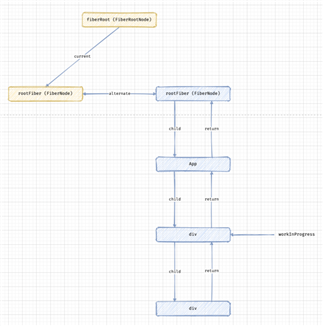
我们先看一下第二个 div 节点:
<div className="section">
<h1>This is the title.</h1>
<p>This is the first paragraph.</p>
<p>This is the second paragraph.</p>
</div>
它比较特殊,有三个字节点,对应的 nextChildren 为

下面我们来看看 React 是如何处理多节点的情况,首先我们还是会进入 reconcileChildFibers 这个方法:
function reconcileChildFibers(
returnFiber: Fiber,
currentFirstChild: Fiber | null,
newChild: any,
lanes: Lanes,
): Fiber | null {
// 省略非核心代码
if (isArray(newChild)) {
return reconcileChildrenArray(
returnFiber,
currentFirstChild,
newChild,
lanes,
);
}
// 省略非核心代码
}
newChild 即是 nextChildren,为数组,会调用 reconcileChildrenArray 这个方法
function reconcileChildrenArray(
returnFiber: Fiber,
currentFirstChild: Fiber | null,
newChildren: Array<*>,
lanes: Lanes,
): Fiber | null {
// 省略非核心逻辑
let previousNewFiber: Fiber | null = null;
let oldFiber = currentFirstChild;
// 省略非核心逻辑
if (oldFiber === null) {
for (; newIdx < newChildren.length; newIdx++) {
const newFiber = createChild(returnFiber, newChildren[newIdx], lanes);
if (newFiber === null) {
continue;
}
lastPlacedIndex = placeChild(newFiber, lastPlacedIndex, newIdx);
if (previousNewFiber === null) {
resultingFirstChild = newFiber;
} else {
previousNewFiber.sibling = newFiber;
}
previousNewFiber = newFiber;
}
return resultingFirstChild;
}
// 省略非核心逻辑
}
下面来总结一下这个方法:
最后我们的 Fiber 树就构建完成了,如下图:
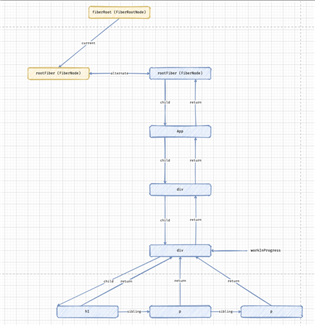
原文:https://www.cnblogs.com/dtux/p/14953844.html